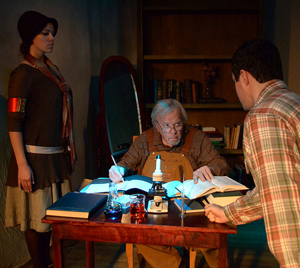
They're all over the headlines today, these robots, even making the cover of Time magazine. To be sure, the automated semi-mobile support staff of today-discounting the old-school androids used in photographs accompanying the aforementioned headlines-bear little similarity to their Hollywood predecessors: Robby in Forbidden Planet, Gort in The Day the Earth Stood Still, R2-D2 and C-3PO in Star Wars, to name a few. Nor is there much family resemblance to their earliest ancestors, originally conceived as an alternative to slaves (the Czech word "robot" means "servant"), and first introduced in Karel Capek's 1922 play, R.U.R. (Rossum's Universal Robots).
The challenge faced by Strangeloop Theatre in replicating these prototypes ninety years later is that we have become accustomed to elaborate special effects suggesting the "otherness" of our man-made assistants. Ironically, we are also quick to dismiss stereotypical traits grown threadbare through overexposure-e.g. monotone voices, stiff-jointed limbs, lurex-infused clothing, etc. When your dramatic universe is populated by mannequins assembled in the Rossum's Universal Robot factory (aka R.U.R.) whose appearance is all but indistinguishable from the flesh-and-blood mortals with whom they co-exist, how far do you go in making the robots act-well, robot-y?
"It's important to remember that this is a very political play," cautions director Brad Gunter, "It explores a number of issues still relevant today-workers' rights, class conflicts, the threat of militarization, the role of technology in society. Capek is casting a critical eye on the global problems of his own times, but he refrains from offering any clear solutions. The play raises the questions, but asks the audience to find the answers. Capek's creations are closer in concept to bio-engineered beings than to the bulky metal mechanoid 'robots' as we understand them."
How is this manifested physically? We don't see connecting bolts and screws, or hear gears grinding, do we? "The robots' bodies remain immobile when not needed for a specific task, even as their heads and faces react." Gunter reminds us, "As the play progresses, though, the robots are seen to evolve, becoming more complex. Marius and Sulla, the robot couple we meet in Act One, are clearly different in design than their 'descendants' in later scenes."
Costume designer Carrie Campana explains, "The clothes are inspired by what audiences in 1922 might have imagined the future to look like. They are clearly based in period styles, but with an edge. The robots will have a slightly tinted skin tone, for example, and a sort of bar code on their wrists."
Gunter concurs, "The robots' garb mostly evoke their functions-industrial coveralls as opposed to the livery of house servants, its practicality contrasting with the formal suits and fashionable dresses that the humans wear. Since the same actors often play multiple robots, this helps to emphasize the 'faceless masses' aspect of these artificial creatures."
The anonymity of low-level employees and their impact on the American economy is a phenomenon recently undergoing close scrutiny in our own culture. What better time to re-assess the difficulties of upwardly-mobile "robots" seeking integration into their former hosts' world of privilege?
R.U.R (Rossum's Universal Robots) runs at the Side Project through October 6.
Mary Shen Barnidge
Contributing Writer

 Follow Us On Twitter
Follow Us On Twitter